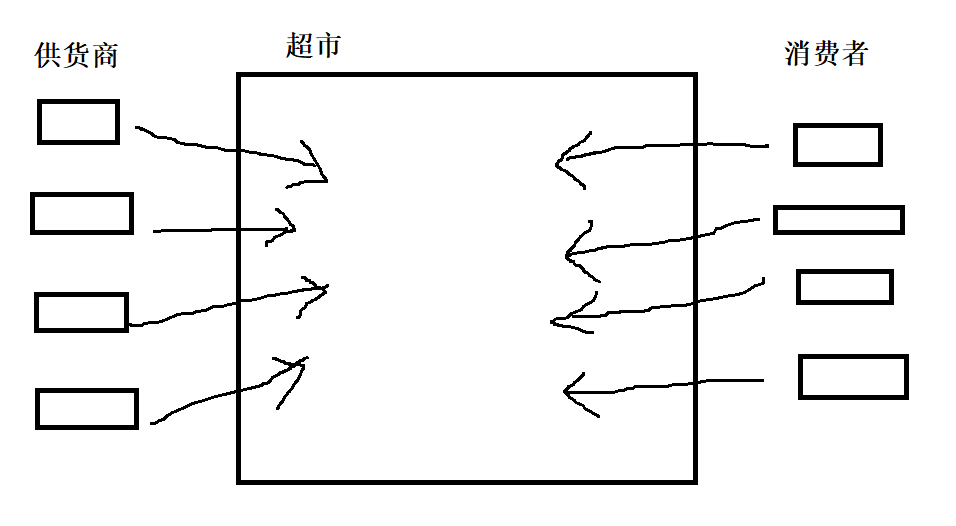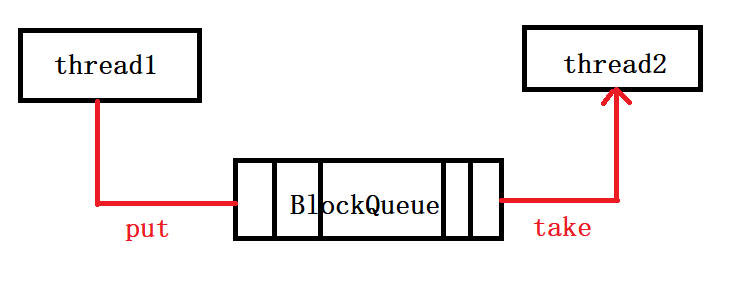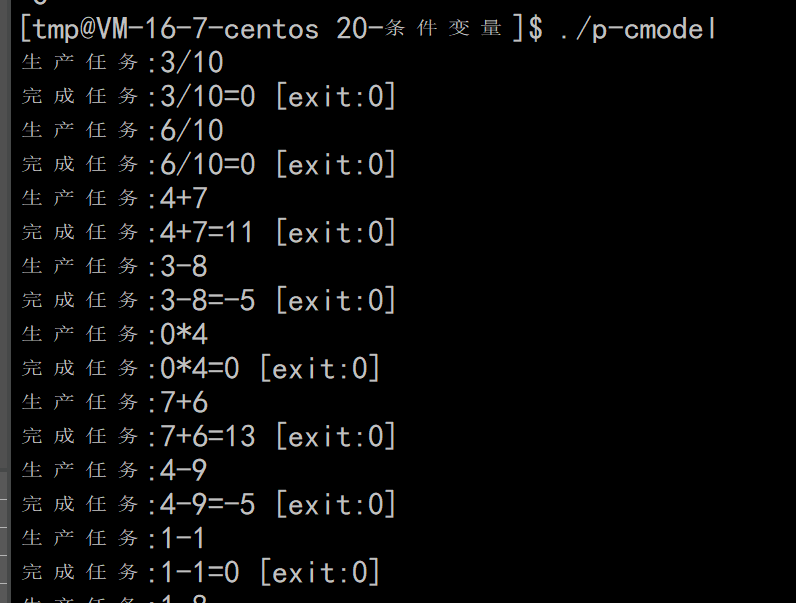生产者消费者模型
概念
为何要使用生产者消费者模型,这个是用过一个容器解决生产者和消费的强耦合问题。生产者和消费者之间不需要通讯,通过阻塞队列通讯,所以生产者生产完数据之后不用等待消费者处理,直接扔给阻塞队列,消费者不找生产者要数据,而是直接从阻塞队列取,阻塞队列相当于缓冲区,平衡了双方的能力,用来解耦的

上面超市的例子。消费者需要泡面的话不用去找供货商要货,而是去超市取。如果找供货商,消费者只需要一包,供货商开启生产设备只生产一包,多次这样很浪费效率也不高。超市作为存储,需要一万包泡面,供货商生产1万包摆到超市里,将超市塞满,缓存起来,调整供货商和消费者的速度不一致导致的效率问题。供货商就可以休息下来。消费者需要几包去超市取,支持了一种忙闲不均的状态。供货商关注超市有多少空位置,需要多少货,消费者关注现有商品的数量。供货商在生产的时候,和消费者没关系,消费者购买的时候和供应商也没关系,双方不需要互相考虑,只完成自己的事情,就减少了依赖性,解耦。
在计算机里,生产者和消费者都是由线程承担,超市是一种特殊结构的内存空间,这个结构是一种共享资源,整个过程就是执行流在通信,如何安全高效的通信。共享资源就有并发的问题,这种并发有三种关系:
生产者和生产者:互斥关系。一个在供货的时候另一个需要等待
生产者和消费者:互斥和同步关系。如果供货商正在摆一个商品,消费者有没有得到。有一种不确定性,生产者要确定,数据安全,只有生产了和没有生产,消费者一定可以得到货物。供货商不停联系超市需不需要货,超市已经满了还在不停询问,占用了消费者询问的机会,导致消费者饥饿问题。所以要同步,保证顺序性。供货商刚供货一次再询问时,告知一段时间之内不要询问,消费者询问没有商品时,也告知没有并一段时间不要询问,安全才是本质
消费者和消费者:互斥关系
321原则
3种关系2种角色1个交易场所
3种关系,生产者和消费者之间互相搭配
2种角色:生产和消费
1个交易场所:特定结构的内存空间
优点:
1.支持忙闲不均
2.支持并发
3.生产和消费进行解耦
什么是解耦。main函数内调用一个函数,传入参数,需要等到函数返回才能继续往下执行,可以将两个分开为线程,参数用一段空间缓存,放到缓冲区里,函数调用时在空间里取,这就是解耦
基于BlockingQueue的生产者模型
BlockingQueue
在多线程编程中阻塞队列(Blocking Queue)是一种常用于实现生产者和消费者模型的数据结构。其与普通的队列区别在于,当队列为空时,从队列获取元素的操作将会被阻塞,直到队列中放入了元素;当队列满时,往队列里存放元素的操作也会被阻塞,直到有元素被从队列中取出(以上的操作都是基于不同的线程来说的,线程在对阻塞队列进程操作时会被阻塞)
类似于管道

类的设计
首先需要数据存储的结构,这个用队列,一个容量设置为队列允许存放的最多数量。对队列的访问同一时间只能有一方,所以需要一个锁。类提供存入数据和取出数据的功能,生产者关心的是还能放多少数据,如果大于最大容量就要停止,所以要判断队列的现有数量,这是对共享资源的访问,加锁和释放锁,判断大于容量时就去条件变量队列等待,同样,消费者取物品也需要一个条件变量,消费者判断有没有商品,没有就到消费者的条件变量等待。当生产者生产出一个商品放入后就唤醒消费者取,消费者取完唤醒生产者生产
#include <queue>
#include <pthread.h>template<class T>
class BlockQueue
{static const int defaultnum = 20;
public:BlockQueue(int cap = defaultnum){_maxcap = cap;pthread_mutex_init(&_mutex, nullptr);pthread_cond_init(&_pcond, nullptr);pthread_cond_init(&_ccond, nullptr);_lowwater = _maxcap / 3;_highwater = _maxcap / 3 * 2;}void push(const T& x){pthread_mutex_lock(&_mutex);if (_que.size() == _maxcap) //防止被伪唤醒的状态 {pthread_cond_wait(&_pcond, &_mutex); //调用,自动释放锁}_que.push(x); //确保生产条件满足才能生产//if (_que.size() > _highwater)pthread_cond_signal(&_ccond);pthread_mutex_unlock(&_mutex);}T pop(){pthread_mutex_lock(&_mutex);if (_que.size() == 0){pthread_cond_wait(&_ccond, &_mutex);}T tmp = _que.front();_que.pop();//if (_que.size() < _lowwater)pthread_cond_signal(&_pcond);pthread_mutex_unlock(&_mutex);return tmp;}~BlockQueue(){pthread_mutex_destroy(&_mutex);pthread_cond_destroy(&_pcond);pthread_cond_destroy(&_ccond);}private:std::queue<T> _que;int _maxcap; //最大容量pthread_mutex_t _mutex;pthread_cond_t _pcond;pthread_cond_t _ccond;int _lowwater;int _highwater; //控制水位线
};
阻塞队列设置为了模板,不只可以放入内置类型,也可以是自定义类型。弄一个任务类,有两个操作数,操作符加减乘除随机。一个变量记录结果,一个记录可靠性,如果有除0错误设置为对应值。提供返回string类型整个表达式的内容功能
#pragma once
#include <stdio.h>
#include <string>enum
{DIVZERO = 1,UNKNOW
};
std::string g_op = "+-*/";
struct task
{
public:task(int a, int b, char op):_a(a), _b(b), _op(op), _result(0), _exitcode(0){}void run(){switch(_op){case '+':_result = _a + _b;break;case '-':_result = _a - _b;break;case '*':_result = _a * _b;break;case '/':if (_b == 0){_exitcode = DIVZERO;}else{_result = _a / _b;} break;default:_exitcode = UNKNOW;break;}//printf("%d+%d结果:%d\n", _a, _b, _a + _b);}std::string getresult(){std::string str = std::to_string(_a) + _op + std::to_string(_b);str += "=";str += std::to_string(_result);str += " [exit:";str += std::to_string(_exitcode);str += "]";return str;}std::string gettask(){std::string str = std::to_string(_a) + _op + std::to_string(_b);return str;}private:int _a;int _b;char _op;int _result;int _exitcode;
};
main文件生成两个线程,生产和消费,传入阻塞队列的实例,生产出一个任务,消费者完成
#include <unistd.h>
#include <cstdlib>
#include <iostream>
#include <ctime>
#include "blockqueue.hpp"
#include "task.hpp"void *produce(void *bk)
{BlockQueue<task>* block = static_cast<BlockQueue<task>*>(bk);while (true){int x1 = rand() % 10;usleep(10);int x2 = rand() % 10 + 1;char op = g_op[rand() % 4];task t(x1, x2, op);//生产printf("生产任务:%s\n", t.gettask().c_str());block->push(t);sleep(1);}
}void* consume(void* bk)
{BlockQueue<task>* block = static_cast<BlockQueue<task>*>(bk);while (true){//消费task n = block->pop();n.run();printf("完成任务:%s\n", n.getresult().c_str());sleep(1);}
}int main()
{srand(time(NULL));pthread_t ptid, ctid;BlockQueue<task>* block = new BlockQueue<task>();pthread_create(&ptid, nullptr, produce, block);pthread_create(&ctid, nullptr, consume, block);while (true){sleep(1);}delete block;return 0;
}
结果:

伪唤醒
当队列里只剩一个位置的时候,生产者如果不小心唤醒了多个生产者。这时它们都会去竞争锁,拿到锁的线程去生产然后放入,接着释放锁。正常情况下,应该消费线程拿到这个锁取数据,但因为刚刚唤醒了多个线程,可能会抢到锁继续放入数据,这时就会超出最大容量出现错误。所以要将if处改为循环,释放锁后判断如果满了就调条件变量里休眠
多生产多消费
将上面的单生成单消费改为多生产多消费版本
#include <unistd.h>
#include <cstdlib>
#include <iostream>
#include <ctime>
#include "blockqueue.hpp"
#include "task.hpp"void *produce(void *bk)
{BlockQueue<task>* block = static_cast<BlockQueue<task>*>(bk);while (true){int x1 = rand() % 10;usleep(10);int x2 = rand() % 10 + 1;char op = g_op[rand() % 4];task t(x1, x2, op);//生产printf("%p生产任务:%s\n", pthread_self(), t.gettask().c_str());block->push(t);sleep(1);}
}void* consume(void* bk)
{BlockQueue<task>* block = static_cast<BlockQueue<task>*>(bk);while (true){//消费task n = block->pop();n.run();printf("%p完成任务:%s\n", pthread_self(), n.getresult().c_str());//sleep(1);}
}int main()
{srand(time(NULL));BlockQueue<task>* block = new BlockQueue<task>();pthread_t ptid[3], ctid[5];for (int i = 0; i < 3; i++){pthread_create(&ptid[i], nullptr, produce, block);}for (int i = 0; i < 5; i++){pthread_create(&ctid[i], nullptr, consume, block);}for (int i = 0; i < 3; i++){pthread_join(ptid[i], nullptr);}for (int i = 0; i < 5; i++){pthread_join(ctid[i], nullptr);} delete block;return 0;
}
优势
虽然同一时间只能有一个执行流访问阻塞队列,多个生产者也只能有一个访问队列,那多个生产者和消费者的优势体现在什么地方。
生产者的数据从用户网络等地方获得,数据的获取也需要时间,当一个生产者往队列里放入数据时,其他生产者可以同时获取数据,后面只需要放入数据即可。消费者方拿到数据后要对数据加工处理,这部分也是需要花费时间,同样一个线程获取数据时,其他的可能正在处理获得的数据。所以说,这个模型提高了效率,并发程度,是高效的。
——实现第三人称越肩视角)


-水果分级系统)








)
)





